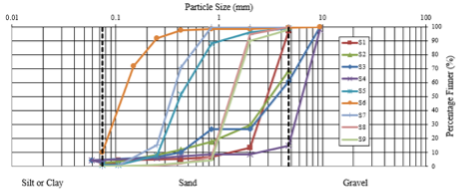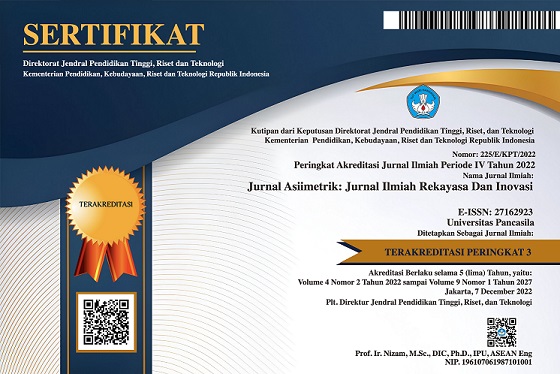Analysis of Sand Grain Characteristics and Permeability Using Hazen Formula and Laboratory Test
DOI:
https://doi.org/10.35814/asiimetrik.v7i2.8871Keywords:
sand permeability, Hazen formula, grain morphology, laboratory test, size distributionAbstract
Permeability is a critical parameter in geotechnical and hydrological studies, representing a soil's capacity to transmit water through its pore spaces. The Hazen formula, an empirical method based on the D10 value from sieve analysis, is widely used to estimate the permeability coefficient. However, its accuracy is strongly influenced by grain shape and size distribution, which vary significantly across different geological settings such as volcanic, fluvial, and coastal environments. This study evaluates the applicability of the Hazen formula for sands derived from these three environments. The novelty of this research lies in its integrated approach, combining visual morphological analysis using sand grain imagery, particle size distribution tests, permeability estimation via the Hazen formula, and validation through constant head laboratory tests. Nine sand samples were analyzed: four from mountainous regions, two from rivers, and three from coastal areas. The findings reveal that sands with angular grains and wide gradation ranges exhibit considerable discrepancies between estimated and measured permeability values. Conversely, sands with rounded and well-sorted grains produce more consistent results. These outcomes suggest that the Hazen formula remains reliable for clean, uniformly graded sands with rounded to sub-rounded particles. This study highlights the need to consider grain morphology when applying empirical permeability estimation methods.
Downloads
References
Akbulut, N., Wiszniewski, M. and Cabalar, A. (2014) ‘Influences Of Grain Shape And Size Distribution On Permeability’, Acta Geotechnica Slovenica, 2016(2), pp. 83–93. Available at: https://doi.org/10.1201/b17395-263.
Albarrán-Ordás, A. and Zosseder, K. (2024) ‘Estimation Of 3-D Hydraulic Conductivity Fields From Fictive Grain-Size Distributions Derived From 3-D Geological Modeling’, Hydrogeology Journal, 32(8), pp. 2121–2145. Available at: https://doi.org/10.1007/s10040-024-02850-7.
Alyamani, M.S. and Şen, Z. (1993) ‘Determination of Hydraulic Conductivity from Complete Grain-Size Distribution Curves’, Groundwater, 31(4), pp. 551–555. Available at: https://doi.org/10.1111/j.1745-6584.1993.tb00587.x.
ASTM (2017) ‘Standard Test Methods for Particle-Size Distribution (Gradation) of Soils Using Sieve Analysis’. ASTM. Available at: https://store.astm.org/d6913-04r09e01.html (Accessed: 11 March 2025).
ASTM (2022) ‘Standard Test Method for Permeability of Granular Soils (Constant Head)’. USA: ASTM. Available at: https://store.astm.org/d2434-19.html (Accessed: 11 March 2025).
Bear, J. (2013) Dynamics of Fluids in Porous Media. Israel: Courier Corporation. [Print]
Carter, M. and Bentley, S.P. (1991) Correlations of Soil Properties. USA: Pentech Press. [Print].
Chapuis, R.P. (2004) ‘Predicting The Saturated Hydraulic Conductivity Of Sand And Gravel Using Effective Diameter And Void Ratio’, Canadian Geotechnical Journal, 41(5), pp. 787–795. Available at: https://doi.org/10.1139/t04-022.
Cho, G.-C., Dodds, J. and Santamarina, J.C. (2006) ‘Particle Shape Effects on Packing Density, Stiffness, and Strength: Natural and Crushed Sands’, Journal of Geotechnical and Geoenvironmental Engineering, 132(5), pp. 591–602. Available at: https://doi.org/10.1061/(ASCE)1090-0241(2006)132:5(591).
Cui, X. et al. (2024) ‘Porosity And Hydraulic Conductivity Of Gap Graded Natural Sand Considering Shape Parameters’, Construction and Building Materials, 438, p. 137163. Available at: https://doi.org/10.1016/j.conbuildmat.2024.137163.
Das, B.M. and Sivakugan, N. (2015) Introduction to Geotechnical Engineering. Cengage Learning. [Print].
Ferdinand, A.M., Dorothée, D.B. and Codjo, A.E. (2023) ‘Experimental Analysis of Hydraulic Conductivity for Saturated Granular Soils’, Geomaterials, 13(3), pp. 71–90. Available at: https://doi.org/10.4236/gm.2023.133006.
Hazen, A. (1892) ‘Some Physical Properties of Sands and Gravels, with Special Reference to Their Use in Filtration’, in Massachusetts State Board of Health. 24th Annual Report, pp. 539–556.
Liu, H. et al. (2024) ‘State-Of-The-Art Review On The Use Of AI-Enhanced Computational Mechanics In Geotechnical Engineering’, Artificial Intelligence Review, 57(8), p. 196. Available at: https://doi.org/10.1007/s10462-024-10836-w.
Muskat, M. and Wyckoff, R.D. (1937) The Flow of Homogeneous Fluids Through Porous Media. 1st edn. USA: McGraw-Hill Book Company, Incorporated. [Print].
Powers, M.C. (1953) ‘A New Roundness Scale For Sedimentary Particles’, Journal of Sedimentary Research, 23(2), pp. 117–119. Available at: https://doi.org/10.1306/D4269567-2B26-11D7-8648000102C1865D.
Tan, X. and Engeda, A. (2016) ‘Performance Of Centrifugal Pumps Running In Reverse As Turbine: Part II- Systematic Specific Speed And Specific Diameter Based Performance Prediction’, Renewable Energy, 99, pp. 188–197. Available at: https://doi.org/10.1016/j.renene.2016.06.052.
Wang, Y. et al. (2024) ‘Available Heavy Metals Concentrations In Agricultural Soils: Relationship With Soil Properties And Total Heavy Metals Concentrations In Different Industries’, Journal of Hazardous Materials, 471, p. 134410. Available at: https://doi.org/10.1016/j.jhazmat.2024.134410.

Downloads
Published
Issue
Section
License
Copyright (c) 2025 Jurnal Asiimetrik: Jurnal Ilmiah Rekayasa & Inovasi

This work is licensed under a Creative Commons Attribution-NonCommercial 4.0 International License.




























